

What this means for you, is that you need to be careful when selecting the stepper motor and power supply to use with this motor driver. When the motor draws too much current, you can damage the driver and the motor will get hot! This means that the current draw depends on the relationship between the inductance and resistance (L/R) of the stepper motor that you connect to it.
#L298n motor driver user manual drivers#
Please contact to our support team at for any question related to shipping.One thing that is very important to remember is that the L298 does not have an easy way to set a current limit unlike other stepper motor drivers like the A4988 ( tutorial).
#L298n motor driver user manual free#
For all the orders above INR 599, we offer a free shipping. We ship to all over India with flat shipping rate of INR 45 for all the orders below INR 599. Please read the product specifications and datasheet before selecting and ordering a product. Moreover we don't accept the return, if the ordered product is not fit for any specific application. We don't accept the returns for the products damanged by improper use of the product. If you receive a different product then the ordered one, please contact us within the 3 days of you receive the product, supported by the proper pictures and description. Once our support team accept the return, we will provide a replacement or a complete refund including the return shipping cost. Once our support team accept the return, we will provide a replacement or a complete refund including the return shipping cost. If you receive a product with a manufacturing defect, please notify us within the 3 days of you receive the product, supported by the proper pictures and description. Below are the conditions where we can accept a return request. The basic dimensions of the L298N Motor Driver module are shown below.ĭue to the type of products we sell, we accept limited returns.


If the operating voltage of the motor is greater than 12V then the built-in regulator will not be able to handle it, so we have to disconnect the regulator by removing the 5V Select Jumper pin and provide a separate 5V power as an input voltage to the 5V screw terminal to power our L298N Driver IC.

If the operating voltage of the motor is less than or equal to 12V than the built-in regulator will power the driver IC, and this regulated 5V can also be obtained as an output voltage from the 5V screw terminal which can be used to power your microcontrollers like Arduino. The L298 IC requires 5V to operate, this is why we have a built-in 5V Linear Regulator. The voltage required to power the motor is provided to the Motor Power and Ground screw terminal, the voltage range should be between 7V to 35V. The motors to be controlled (Motor A and B) are connected to screw terminals. The pinout diagram of the L298N Motor Driver Module is shown below. The voltage rating of these motors can be between 5V to 35V and the peak current value can be up to 2A. The L298N Motor Driver module is based on the L298 Dual Full-Bridge Driver IC and can control the speed and direction of two DC motors (Motor A and Motor B) simultaneously. While the L293D motor driver module can be used for basic low current application the L298N Motor driver module is a high current motor driver with some additional features that are commonly used with Arduino and Raspberry Pi for Robotics applications. This is why we commonly use Motor Driver modules like the L293D Motor Driver Module and the L298N Motor Driver Module. A microcontroller that normally operates on 5V or 3.3V cannot be directly used to control a DC motor operating on higher voltage and current rating.


 0 kommentar(er)
0 kommentar(er)
